17.07.2025
Buyer's Guide: Smoky & Peated Scotch Single Malt Whisky
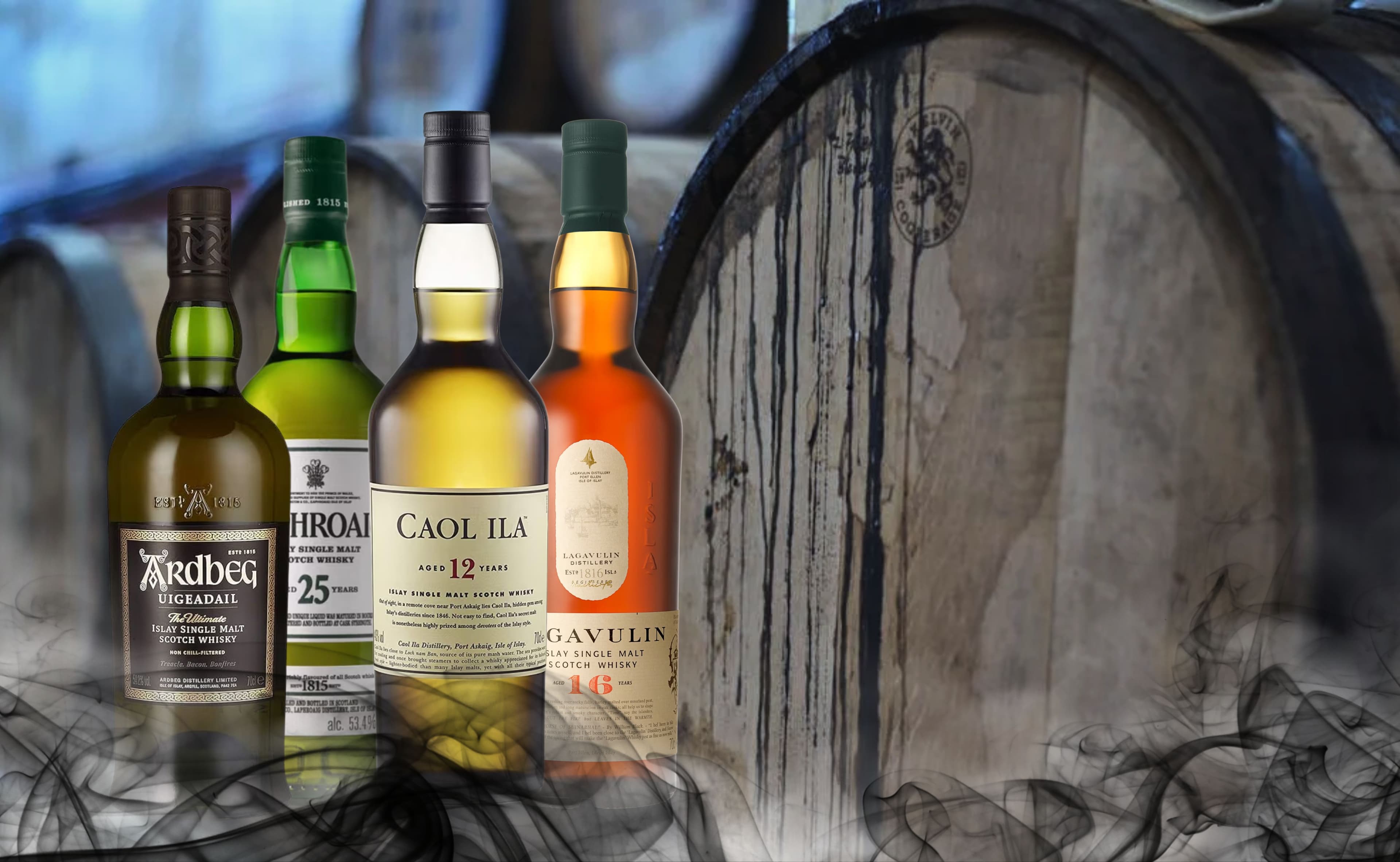
Buyer's Guide: Smoky & Peated Scotch Single Malt Whisky
Smoky and peaty Scotch single malt whisky delivers a unique sensory experience that sets it apart, making it an essential part of any Buyer Guide for whisky enthusiasts. The smoky aroma and bold flavors come from the use of peat during the malting process, a tradition deeply rooted in Scotland. This distinctive profile has captivated whisky enthusiasts and beginners alike.
Over the past decade, the demand for Scotch whisky has surged, which is an important consideration in any Buyer Guide. For example:
-
In 2018, exports reached a record £4.7 billion, reflecting a 7.8% rise in value.
-
Despite challenges like tariffs and the pandemic, 2022 saw exports surpass £6 billion for the first time.
Whether you're drawn to its complexity or intrigued by its rich heritage, smoky peated whisky offers a captivating journey for your palate, making it a must-try as highlighted in any comprehensive Buyer Guide.
Key Takeaways
-
Learn how peat affects whisky. Peat adds a smoky taste, which is important for many whiskies.
-
Check the PPM scale to measure smokiness. Higher PPM means stronger, bolder flavors, helping you pick what you like.
-
Try whiskies from different regions. Places like Islay or Speyside have unique tastes that make your experience better.
-
Begin with easy-to-drink whiskies. New drinkers can start with lighter ones like Glenlivet 12 or Oban 14 to get used to smoky Scotch.
-
Enjoy smoky whiskies with food. Foods like smoked meat or dark chocolate can make peated whiskies taste even better.
What is Peat and Smokiness in Whisky?

The Role of Peat in Scotch Whisky Production
Peat plays a vital role in shaping the character of Scotch whisky. It forms over thousands of years as layers of decayed vegetation compress in waterlogged environments. In Scotland, peat has been a traditional fuel source, and its use in whisky production dates back centuries. During the malting process, distilleries burn peat to dry malted barley, infusing it with a distinctive smoky aroma and flavor.
Peat is central to the flavor of most Scotch whiskies, but its use has sparked environmental concerns. Pungent peat fires impart a rich smokiness that defines many whiskies. Peat is not just a fuel; it is a cornerstone of Scotland’s history and culture, particularly on Islay, where it has shaped the island’s identity for generations.
The whisky industry uses approximately 7,000 tons of dry peat annually, accounting for about 3% of the UK’s extracted peat. Around 80% of Scotch whiskies are estimated to be peated, showcasing the widespread influence of this natural resource.
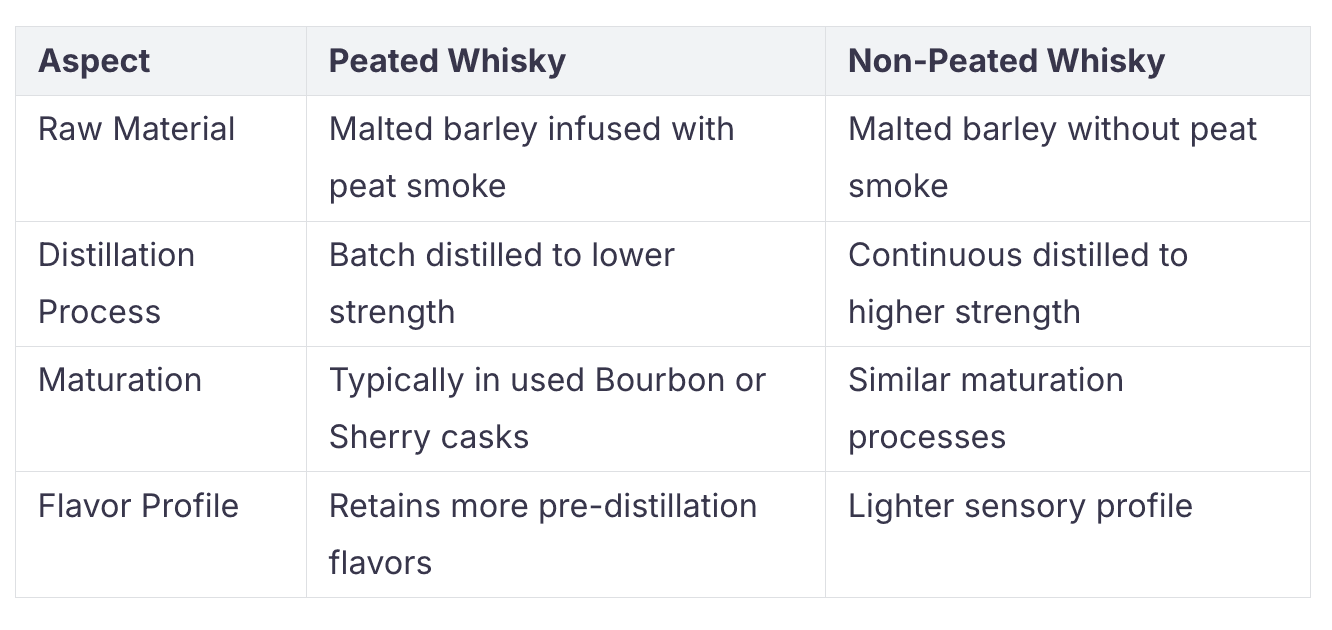
How the Malting Process Creates Smoky Flavors
The malting process is where the magic of smokiness begins. Barley grains are soaked in water to germinate, then dried using heat. When peat is burned during this drying stage, the smoke rises and infuses the barley with phenolic compounds. These compounds are responsible for the smoky, peaty flavors that define certain Scotch whiskies.
Allan Logan, a whisky expert, explains that the type of peat used can significantly influence the flavor. For instance, peat from coastal regions may impart briny, medicinal notes, while inland peat might produce earthy or mossy flavors. The distillation process further refines these flavors, with factors like still shape and cut points playing a crucial role in balancing smokiness with other taste dimensions.
Understanding the PPM Scale in Peated Whisky
The PPM (Phenol Parts per Million) scale measures the phenol content in malted barley after kilning. This scale helps distilleries and consumers gauge the intensity of peatiness in a whisky. While not an exact science, it provides a useful benchmark for understanding flavor profiles.
-
A PPM of 1-10 indicates a lightly peated whisky, offering subtle smoky hints.
-
A PPM of 10-30 delivers moderate smokiness, ideal for those seeking balance.
-
A PPM above 30 represents bold, heavily peated whiskies with intense flavors.
The PPM scale reflects the smoky character derived from peat smoke, but it doesn’t account for how the distillation and maturation processes might alter the final flavor. For example, a whisky with a high PPM might taste less smoky after years of aging in oak casks, as the flavors mellow and integrate.
Flavor Profiles by Scotch Whisky Regions
Islay: The Best Peated Whiskeys with Intense Smokiness
The Islay region of Scotland is renowned for producing some of the most intensely smoky and heavily peated whisky in the world. This distinct character stems from the high concentration of phenolic compounds found in Islay peat, as highlighted by Barry Harrison's research. These compounds contribute to the bold, medicinal, and maritime flavors that define Islay whiskies. The peating process, which involves burning peat to dry malted barley, plays a crucial role in creating these unique profiles.
Islay whiskies often feature notes of burnt wood, seaweed, and iodine, making them a favorite among enthusiasts seeking the best intense peat experience. The island's coastal environment further enhances these flavors, adding a briny, salty edge. Popular distilleries like Laphroaig, Ardbeg, and Lagavulin exemplify the region's signature style, offering single malts that are both complex and unforgettable.
Highlands: Balanced and Subtle Smoky Notes
Highland whiskies provide a more balanced approach to smokiness, making them an excellent choice for those who prefer subtle flavors. These whiskies often combine soft peat smoke with sweeter notes like orange, vanilla, and sherry. A tasting report describes Highland whiskies as offering "appetizing sweet flavors complemented by soft smoke, wood, and spice."
The region's diverse geography allows for a wide range of flavor profiles, from the floral and heathery notes of the northern Highlands to the richer, spicier expressions found in the south. This versatility makes Highland whiskies a versatile option for both beginners and seasoned drinkers.
Speyside: Lightly Peated and Accessible Options
Speyside whiskies are known for their light, approachable profiles, often with minimal peat influence. This allows the fruity, honeyed, and vanilla notes to shine through. The region's mild climate and access to high-quality water contribute to the production of these lighter spirits. Techniques like double distillation and aging in sherry casks further enhance their sweet and fruity characteristics.
For those new to Scotch, Speyside offers an excellent entry point. The lack of heavy peat makes these whiskies more accessible, while their complexity ensures they remain interesting for experienced drinkers. Distilleries like Glenfiddich and Macallan are iconic examples of Speyside's style, producing single malts that are both elegant and widely loved.

Other Regions: Unique Interpretations of Peated Whisky
While Islay and other well-known regions dominate the conversation about peated whisky, other parts of Scotland and the world offer unique takes on this smoky spirit. These regions bring their own terroir, techniques, and traditions to the table, creating whiskies that stand out in flavor and character.
Campbeltown: A Hidden Gem
Campbeltown, once a bustling hub for whisky production, now hosts only a few distilleries. Despite its small size, this region produces peated whiskies with a distinctive maritime influence. You’ll notice flavors of brine, seaweed, and a touch of smoke. Springbank and Glen Scotia are two distilleries worth exploring if you’re curious about Campbeltown’s offerings.
Islands Beyond Islay
The islands surrounding Scotland, such as Skye, Jura, and Orkney, also produce exceptional peated whiskies. These whiskies often combine smoky notes with flavors influenced by the sea. For example, Talisker from Skye delivers a peppery, smoky profile, while Highland Park from Orkney balances peat with honeyed sweetness. Each island offers a unique interpretation of peated whisky, making them a must-try for adventurous drinkers.
Global Interpretations
Peated whisky isn’t limited to Scotland. Countries like Japan and India have embraced peat in their whisky-making processes. Japanese distilleries, such as Hakushu, craft whiskies with a delicate balance of smoke and floral notes. Indian brands like Amrut experiment with peat to create bold, tropical flavors. These global expressions showcase how peat can adapt to different climates and cultures.
Tip: When exploring whiskies from lesser-known regions, start with smaller bottles or sample packs. This approach allows you to discover new favorites without committing to a full-sized bottle.
Whisky Buying Guide: Choosing the Right Smoky or Peated Whisky
Determining Flavor Intensity: Mild, Medium, or Bold
When choosing a smoky or peated whisky, understanding flavor intensity is crucial. The intensity often depends on the level of peat used during production and how it interacts with other elements like cask aging and distillation techniques. You can classify smoky whiskies into three main categories: mild, medium, and bold.
-
Mild: These whiskies offer a gentle introduction to peat and smoke. They typically feature subtle smoky hints balanced with sweeter or fruitier notes. For example, Oban 14 combines a light smoky flavor with sweet and salty undertones, making it an excellent choice for beginners.
-
Medium: Whiskies in this category strike a balance between peat and other flavors. They provide a noticeable smoky profile without overwhelming the palate. Single malt scotches in this range often showcase a mix of smoke, honey, and floral notes, offering complexity without intensity.
-
Bold: If you enjoy a powerful, peaty punch, bold whiskies are for you. These whiskies, like Ardbeg 10, deliver strong peat flavors that dominate the palate. They often include medicinal, maritime, or earthy notes, making them a favorite among seasoned enthusiasts.
Tip: Start with mild or medium options if you're new to smoky whisky. Gradually explore bolder expressions as your palate becomes accustomed to the intensity.
Considering Age, Maturation, and Complexity
Age and maturation play a significant role in shaping the flavor and complexity of whisky. As whisky ages in oak casks, it undergoes chemical transformations that enhance its character. Compounds like esters, acids, and phenols interact with the wood, creating layers of flavor that evolve over time.
-
Younger Whiskies (3-10 years): These whiskies often retain more of the raw, peaty flavors from the distillation process. They tend to be vibrant and bold but may lack the smoothness of older whiskies.
-
Older Whiskies (12+ years): With age, the smoky and peaty notes mellow, allowing other flavors like vanilla, dried fruit, or spice to emerge. The cask's influence becomes more pronounced, adding depth and complexity.
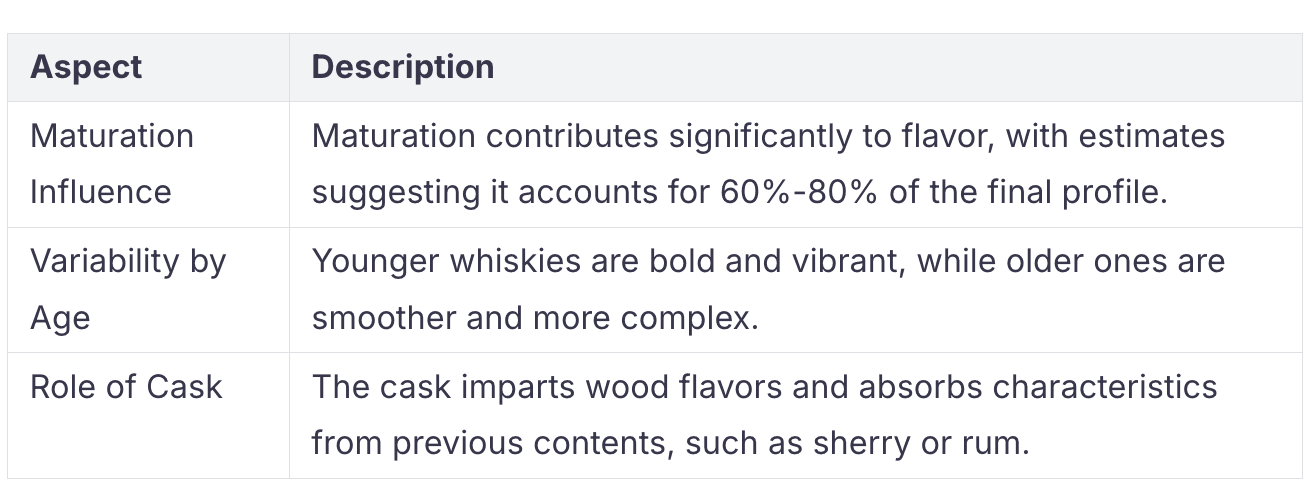
For example, whiskies aged in sherry casks often develop rich, fruity flavors, while those aged in bourbon barrels may exhibit vanilla and caramel notes. The Islay region, known for its peated single malt whiskies, often uses casks that enhance the smoky profile while adding layers of maritime or briny flavors.
Note: Age is not always an indicator of quality. Some younger whiskies offer exceptional flavor profiles, especially when crafted with care.
Balancing Quality and Budget for Your Purchase
Finding the right balance between quality and budget is one of the most important factors to consider when buying whisky. While premium single malt whiskies and aged expressions often come with higher price tags, you can still find excellent options within a reasonable budget.
-
Set a Budget: Determine how much you're willing to spend. Keep in mind that older or rarer whiskies tend to be more expensive.
-
Consider Value: Look for whiskies that offer a good balance of flavor and price. For instance, blended scotch whisky can provide excellent quality at a lower cost compared to single malt whisky.
-
Explore Smaller Bottles: Many distilleries offer smaller bottles or sample packs, allowing you to try different whiskies without a significant investment.
-
Research Distilleries: A distillery's reputation can be a good indicator of quality. Established names like Laphroaig or Glenfiddich often produce consistently high-quality whiskies.
The whisky market has seen a growing trend toward premiumization, with more consumers seeking handcrafted and small-batch options. Younger generations, particularly millennials, are exploring new styles and brands, moving beyond traditional perceptions of scotch. This shift has led to the emergence of boutique producers offering unique, high-quality whiskies at competitive prices.
Tip: Attend whisky-tasting events or join online communities to discover hidden gems and get recommendations tailored to your taste and budget.
Tips for Beginners Exploring Smoky and Peated Whiskies
Exploring smoky and peated whiskies can be an exciting journey for beginners. These whiskies offer unique flavors and aromas that set them apart from other spirits. To help you navigate this fascinating category, here are some practical tips to enhance your experience.
Start with Approachable Whiskies
Begin your journey with whiskies that offer mild smoky notes and balanced flavors. These options allow you to ease into the world of peated Scotch without overwhelming your palate.
-
The Glenlivet 12 Single Malt: This whisky is smooth and approachable, featuring tropical fruit notes that make it ideal for new Scotch drinkers.
-
Oban 14: Known for its light smokiness and sweet undertones, this whisky provides a gentle introduction to peated single malts.
-
Highland Park 12: A versatile choice with a subtle smoky profile complemented by honey and spice.
These whiskies showcase the diversity of Scotch and help you develop an appreciation for its complexity.
Explore Different Regions
Scotland’s whisky regions offer distinct interpretations of smoky and peated flavors. Sampling whiskies from various regions can deepen your understanding of their unique characteristics.
-
Islay: Known for bold, heavily peated whiskies with maritime and medicinal notes.
-
Highlands: Offers balanced expressions with soft smoke and sweeter flavors.
-
Speyside: Features lightly peated whiskies with fruity and honeyed profiles.
Tip: Create a tasting map to track the regions you’ve explored. This visual guide can help you identify your preferences and plan future tastings.
Use the PPM Scale as a Guide
The PPM (Phenol Parts per Million) scale measures the intensity of peat in whisky. Use this scale to select whiskies that match your comfort level.

Start with lower PPM whiskies and gradually explore bolder options as your palate adapts.
Pair Wisely
Pairing smoky whiskies with food can enhance their flavors and make them more approachable. Foods with rich, savory profiles complement the smokiness well.
-
Cheese: Aged cheddar or blue cheese pairs beautifully with peated whiskies.
-
Smoked Meats: Bacon or smoked salmon enhances the whisky’s smoky character.
-
Dark Chocolate: The bitterness of dark chocolate balances the whisky’s bold flavors.
Experiment with pairings to discover combinations that suit your taste.
Take Your Time
Smoky and peated whiskies are complex and layered. Take your time to savor each sip and identify the flavors. Use a nosing glass to concentrate the aromas and enhance your tasting experience.
Tip: Keep a tasting journal to record your impressions. Note the flavors, aromas, and regions you enjoy most. This practice helps refine your preferences and guides future purchases.
Join Whisky Communities
Engaging with whisky enthusiasts can provide valuable insights and recommendations. Online forums, social media groups, and local tasting events are excellent places to connect with others who share your interest.
Tip: Look for beginner-friendly events or virtual tastings. These settings often include guided sessions that explain the nuances of smoky and peated whiskies.
By following these tips, you can confidently explore the world of smoky and peated whiskies. Each sip offers a new opportunity to discover the rich heritage and diverse flavors of Scotch.
Top Recommendations for Smoky and Peated Whiskies
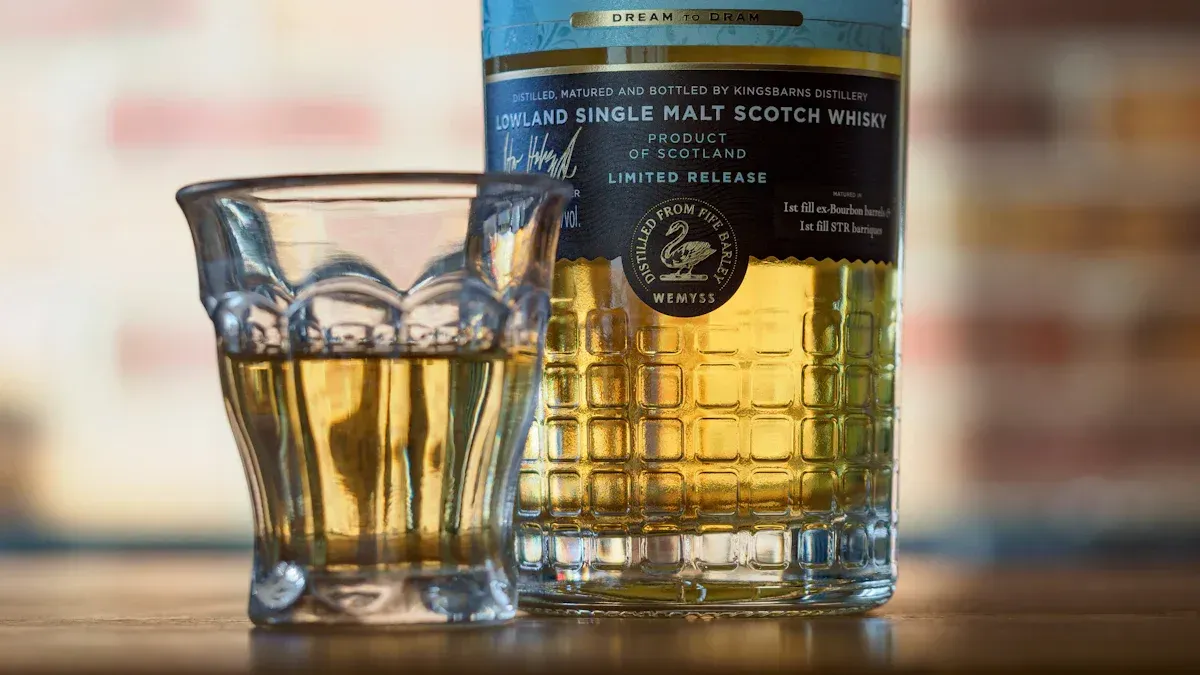
Best Peated Whiskeys for Beginners: Mild and Approachable
If you're new to peated whisky, starting with mild and approachable options can help you ease into the smoky world of Scotch. These whiskies balance subtle peat flavors with sweeter or fruitier notes, making them ideal for beginners.
-
Caol Ila 12 Years: This Islay single malt offers a gentle introduction to peat. Its light smokiness is complemented by sea breeze and citrus notes, creating a refreshing and approachable profile.
-
Lagavulin 16 Years: Known for its balanced character, this whisky combines peat with sweetness. Expect flavors of seaweed, vanilla, and dried fruit, making it a favorite for those starting their smoky journey.
These whiskies showcase the diversity of Scotland's regions while remaining accessible to new drinkers. Their mild profiles allow you to explore the complexity of peated Scotch without overwhelming your palate.
Best for Smoky Whisky Enthusiasts: Bold and Intense Choices
For seasoned enthusiasts, bold and intense smoky whiskies deliver a powerful sensory experience. These whiskies feature high levels of peat and complex flavor profiles that captivate the palate.
-
Bruichladdich Octomore: Often referred to as the "world's most heavily peated whisky," Octomore offers an unparalleled intensity. Its smoky character is balanced by surprising notes of fruit and spice.
-
Ardbeg Uigeadail: This Islay single malt combines bold peat with rich sherry cask influences. The result is a whisky with layers of smoke, dried fruit, and dark chocolate.
-
Balcones Peated Texas Single Malt: An American take on peated whisky, this expression delivers high-proof intensity with notes of smoke, oak, and caramel.
These whiskies push the boundaries of peat and smoke, offering a thrilling experience for those who crave bold flavors.
Best for Collectors: Rare and Aged Peated Scotch
Rare and aged peated Scotch whiskies hold a special allure for collectors. These bottles often feature limited production runs, unique cask finishes, and decades of maturation, making them highly sought after.
-
Laphroaig 25 Years: This iconic Islay whisky combines intense peat with the smoothness of long aging. Its flavors of smoke, oak, and dried fruit make it a collector's dream.
-
Macallan Rare Cask Black: While Macallan is better known for its unpeated whiskies, this rare expression features a subtle smoky profile with rich sherry influences.
-
Springbank 21 Years: From Campbeltown, this whisky offers a unique blend of peat, maritime notes, and tropical fruit, showcasing the region's distinctive style.
Collectors value these whiskies not only for their exceptional flavors but also for their investment potential. Limited releases and unique production methods make them prized additions to any collection.
Tip: When collecting rare whiskies, consider factors like production limits, cask types, and brand reputation. These elements can influence both the flavor and future value of your investment.
Budget-Friendly Picks: Affordable Yet Flavorful Options
You don’t need to spend a fortune to enjoy a quality smoky whisky. Scotland offers a variety of affordable options that deliver exceptional flavor without breaking the bank. These whiskies prove that great taste doesn’t always come with a hefty price tag.
Top Budget-Friendly Picks
-
Ardmore Legacy: This Highland single malt combines gentle peat smoke with notes of honey and spice. It’s an excellent introduction to smoky flavors at a wallet-friendly price.
-
Laphroaig Select: Known for its bold Islay character, this whisky balances peat with hints of vanilla and citrus. It’s a great choice for those seeking a smoky experience on a budget.
-
BenRiach The Smoky Ten: This Speyside single malt offers a unique twist with layers of orchard fruit, oak, and subtle smoke. Its approachable price makes it a standout option.
Why These Whiskies Stand Out
Affordable whiskies often showcase the craftsmanship of Scotland’s distilleries. They may use younger spirits or simpler cask finishes, but they still deliver rich and satisfying flavors. For example, Ardmore Legacy uses traditional peat-drying methods to create its signature smoky profile. Similarly, BenRiach experiments with different cask types to add complexity without raising costs.
Tip: Look for whiskies labeled as “NAS” (No Age Statement). These often blend younger and older spirits, offering excellent value for money.
How to Maximize Value
Consider purchasing smaller bottles or sample packs to explore different brands. Many distilleries offer these options, allowing you to try a variety of whiskies without committing to a full-sized bottle. You can also watch for sales or discounts at local retailers or online stores.
By choosing wisely, you can enjoy the rich heritage and flavors of Scotch whisky without overspending.
Smoky and peated Scotch single malt whisky offers a rich tapestry of flavors shaped by Scotland’s diverse regions. From the bold, fiery whiskies of Islay to the delicate, fragrant spirits of the Lowlands, each region brings unique characteristics to the table.
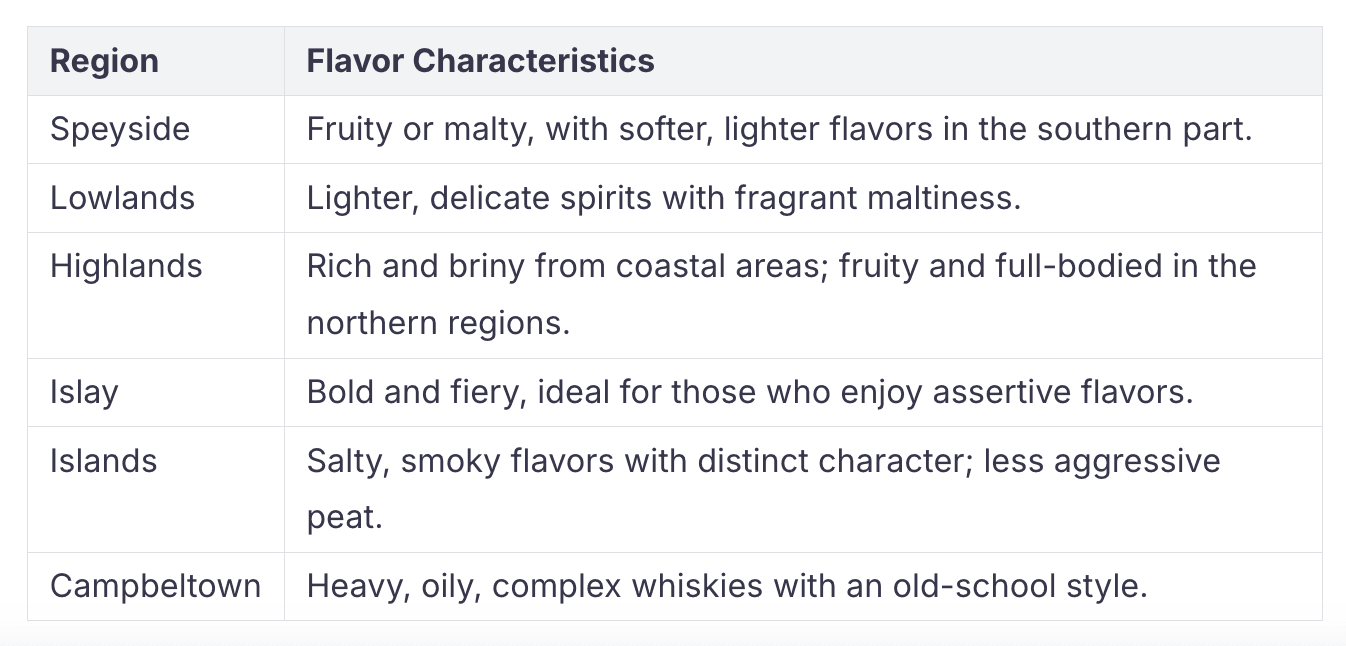
Exploring these regions allows you to uncover whiskies that match your taste preferences. Pairing smoky whiskies with food enhances the experience. Citrus-infused dishes like chicken piccata complement the smoky saltiness, while well-seasoned meals such as General Tso’s chicken amplify the bold flavors of Islay malts.
Tip: Take your time to savor each sip and experiment with pairings to discover your perfect match.
Studies analyzing molecular components of whiskies validate the importance of exploring diverse flavor profiles. By venturing beyond traditional boundaries, you can find exceptional whiskies that surprise and delight your palate.
FAQ
What is the difference between smoky and peated whisky?
Peated whisky gets its smoky flavor from burning peat during the malting process. Smoky whisky refers to the flavor profile, which can result from peat or other factors like cask aging. All peated whiskies are smoky, but not all smoky whiskies are peated.
How do I know if a whisky is heavily peated?
Check the PPM (Phenol Parts per Million) rating on the bottle or distillery notes. Whiskies with a PPM above 30 are considered heavily peated. Examples include Ardbeg 10 and Bruichladdich Octomore.
Tip: If no PPM is listed, research the distillery’s style for clues.
Can beginners enjoy smoky and peated whiskies?
Yes! Start with lightly peated options like Highland Park 12 or Caol Ila 12. These whiskies balance smoke with sweeter or fruitier notes, making them approachable for new drinkers.
Pro Tip: Pair with food like smoked salmon or dark chocolate to soften the intensity.
Does age affect the smokiness of whisky?
Yes, aging mellows the smoky flavors as the whisky interacts with the cask. Younger whiskies (3-10 years) often taste bolder and smokier, while older ones (12+ years) develop smoother, more complex profiles.

Are smoky whiskies only made in Scotland?
No. While Scotland is famous for smoky whiskies, other countries like Japan, India, and the U.S. also produce them. Brands like Hakushu (Japan) and Amrut (India) offer unique interpretations of peated whisky.
Fun Fact: Texas-based Balcones creates smoky whiskies using local peat and oak.
About the author

Janis Wilczura
I started my Whisky journey like many others - I have had a friend who was already into it. After some time in Montreal I moved to Munich in 2015 where I met one of my best friends Ferdinand who was passionate about Whisky already and shared his enthusiasm with me. I fell in love with this product and today I can say that Whisky is more for me than just "Alcohol" it's craftmanship, art and truly something special. Over the course of the past years I have managed to become one of the leading experts in Whisky in Germany featuring articles ar BILD.de, Handelsblatt, Sueddeutsche, Playboy, Business Punk and many more.
To the author